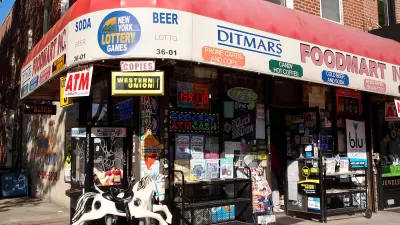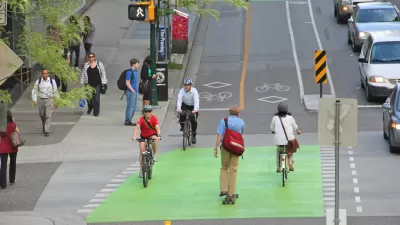Kin, a new partnership between the real estate company Tishman Speyer and the co-living company Common, bets that residents will accept smaller living spaces in exchange for a community borne out of in-house sharing-economy amenities.

Patrick Sisson's Curbed article, "In the apartment amenity arms race, service and technology win out," exemplifies the adolescence of the burgeoning world of luxury apartment design. Like teenagers, these buildings want so badly to be recognized as unique that they're willing to try anything. And at first it works—they have a tree house! or a hallway inspired by the movie 2001! But just like with real people, the best way to define your identity is not to cover yourself in bells and whistles, but to express your values through action.
This quote below demonstrates the trap developers fall into.
"The top two ways to separate yourself in a market that's seen so much activity is adding an infusion of technology, and giving your residence some kind of identity," says Shauntá Bruner, a senior associate with Delta Associates, a commercial real estate research firm. "Everybody has a rooftop grilling area or a dog park. Successful developers need to create things that tell a story and tie together the community." Bruner says that this boils down to better tech and more services.
Bruner starts out on the right track (i.e., give your building an identity and have it tell a story) but the record scratches at the end: How do "better tech" and "more services" build an identity or tell a story? While it's conceivable that a certain suite of amenities may attract like-minded tenants, amenities—especially tech-based amenities—obsolesce quickly, and their lack of staying power translates into an inability to tell any sort of cohesive story or unite a community.
Later, the piece dives into the heart of the matter, which is that developers and apartment managers haven't yet mastered the art of building communities in apartment buildings. Cities are both notorious and adored for their anonymity. Countering that prevailing mindset is a massive challenge. As Bruner says, people need to learn how to make friends within their own building. So instead of just offering yoga studios, developers and building managers supply actual yoga teachers.
Kin, the arm of Tishman Speyer launched in partnership with co-living company Common, is wagering that the best way to goad residents into making friends is through the sharing economy. It's novel to see the market used as a tool to seed community. Capitalism is good for many things, but it hasn't exactly earned its stars as a uniting factor. Can it work?
This is how Kin envisions seeing relationships through the sharing economy: say you need a babysitter and another family in the building also needs a babysitter on the same night. Through the building’s concierge, you can arrange to share the babysitter, thus decreasing your cost, and possibly meeting a friend in the process.
The challenge is that in this scenario, the actions used as the basis of friendship formation—finding a babysitter—aren't particularly meaningful. If developers want to create buildings with identity, then what they're really after are meaningful experiences for their residents, and then connecting those experiences with the building. Those tasks require a much more complicated approach than selecting from a menu of hot new amenities.
You have to ask yourself: how often have you become close friends with the person you run into at the mailbox or with whom you share a dog-walker? Proximity does breed attraction, as the saying goes, but if you're looking to seed durable relationships then you'd be better served if the shared activity itself had some meaning beyond time and cost-savings. If urban dwellers are increasingly moving into high rises and using them as community-defining spaces, then the durability of those communities will depend on intentional community-building actions.
Kin would be wise to design their community building not just around everyday resource sharing, but also around low-level lifecycle events—moments that encourage people to think about the passage of time or their roles in the community. There's a reason religious congregations, with their traditions and ability to house lifecycle events, have historically offered such a successful and stable platform for community growth. Proximity and cost-sharing does not have the same heft.
Building managers would take on a vastly more significant role in this system, functioning not just as a hotel concierge, but also, as crazy as it sounds, in the role of quasi-clergy. Building managers could leverage their building's open spaces to host preschool graduations or school plays so that residents associate their spaces, and the faces they see in them, with moments in their lives that have real meaning. Because it's at those moments that people are present and open to making stronger connections.
From a real estate value prospective, a building that creates actual community becomes more valuable, because while tech amenities look great today, they will inevitably look passé within two years. Friendships and communities, however, last much longer.
Lev Kushner is the founder of Department of Here, an urban brand strategy agency that builds cities of the future so they are more human, relatable, and engaging.

Alabama: Trump Terminates Settlements for Black Communities Harmed By Raw Sewage
Trump deemed the landmark civil rights agreement “illegal DEI and environmental justice policy.”

Study: Maui’s Plan to Convert Vacation Rentals to Long-Term Housing Could Cause Nearly $1 Billion Economic Loss
The plan would reduce visitor accommodation by 25% resulting in 1,900 jobs lost.

Planetizen Federal Action Tracker
A weekly monitor of how Trump’s orders and actions are impacting planners and planning in America.

Waymo Gets Permission to Map SF’s Market Street
If allowed to operate on the traffic-restricted street, Waymo’s autonomous taxis would have a leg up over ride-hailing competitors — and counter the city’s efforts to grow bike and pedestrian on the thoroughfare.

Parklet Symposium Highlights the Success of Shared Spaces
Parklets got a boost during the Covid-19 pandemic, when the concept was translated to outdoor dining programs that offered restaurants a lifeline during the shutdown.

Federal Homelessness Agency Places Entire Staff on Leave
The U.S. Interagency Council on Homelessness is the only federal agency dedicated to preventing and ending homelessness.
Urban Design for Planners 1: Software Tools
This six-course series explores essential urban design concepts using open source software and equips planners with the tools they need to participate fully in the urban design process.
Planning for Universal Design
Learn the tools for implementing Universal Design in planning regulations.
Caltrans
Smith Gee Studio
Institute for Housing and Urban Development Studies (IHS)
City of Grandview
Harvard GSD Executive Education
Toledo-Lucas County Plan Commissions
Salt Lake City
NYU Wagner Graduate School of Public Service





























